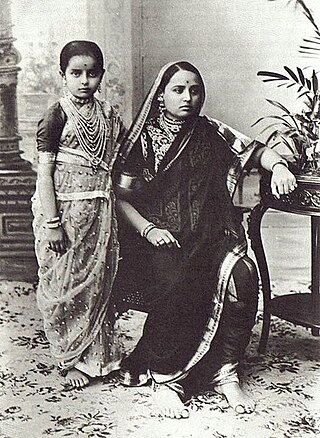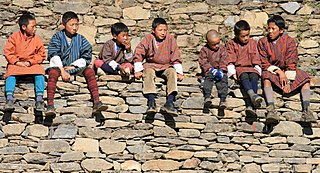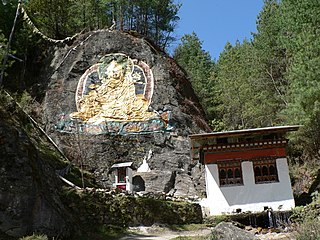Related Research Articles

The kimono is a traditional Japanese garment and the national dress of Japan. The kimono is a wrapped-front garment with square sleeves and a rectangular body, and is worn left side wrapped over right, unless the wearer is deceased. The kimono is traditionally worn with a broad sash, called an obi, and is commonly worn with accessories such as zōri sandals and tabi socks.

Cradled in the folds of the Himalayas, Bhutan has relied on its geographical isolation to protect itself from outside cultural influences. A sparsely populated country bordered by India to the south, and China to the north, Bhutan has long maintained a policy of strict isolationism, both culturally and economically, with the goal of preserving its cultural heritage and independence. Only in the last decades of the 20th century were foreigners allowed to visit the country, and only then in limited numbers. In this way, Bhutan has successfully preserved many aspects of its culture, which dates directly back to the mid-17th century.

A sari is a women's garment from the Indian subcontinent, that consists of an un-stitched stretch of woven fabric arranged over the body as a robe, with one end attached to the waist, while the other end rests over one shoulder as a stole (shawl), sometimes baring a part of the midriff. It may vary from 4.1 to 8.2 metres in length, and 60 to 120 centimetres in breadth, and is form of ethnic wear in Bangladesh, India, Pakistan, Sri Lanka, and Nepal. There are various names and styles of sari manufacture and draping, the most common being the Nivi style. The sari is worn with a fitted bodice also called a choli and a petticoat called ghagra, parkar, or ul-pavadai. It remains fashionable in the Indian Subcontinent today.

A folk costume expresses a national identity through clothing or costume, which is usually associated with a specific region or period of time in history. It can also indicate social, marital, or religious status. If the costume is used to represent the culture or identity of a specific ethnic group, it is usually known as ethnic costume. Such costumes often come in two forms: one for everyday occasions, the other for traditional festivals and formal wear. The word "costume" in this context is sometimes considered pejorative due to the multiple senses of the word, and in such cases "clothing", "garments" or "regalia" can be substituted without offense.

A sarong or a sarung is a large tube or length of fabric, often wrapped around the waist, worn in Southeast Asia, South Asia, Western Asia, Northern Africa, East Africa, West Africa, and on many Pacific islands. The fabric often has woven plaid or checkered patterns, or may be brightly colored by means of batik or ikat dyeing. Many modern sarongs have printed designs, often depicting animals or plants. Different types of sarongs are worn in different places in the world, notably the lungi in the Indian subcontinent and the izaar in the Arabian Peninsula.
Clothing in India varies with the different ethnicities, geography, climate, and cultural traditions of the people of each region of India. Historically, clothing has evolved from simple garments like kaupina, langota, achkan, lungi, sari, to rituals and dance performances. In urban areas, western clothing is common and uniformly worn by people of all social levels. India also has a great diversity in terms of weaves, fibers, colors, and the material of clothing. Sometimes, color codes are followed in clothing based on the religion and ritual concerned. The clothing in India also encompasses a wide variety of Indian embroidery, prints, handwork, embellishments, and styles of wearing clothes. A wide mix of Indian traditional clothing and western styles can be seen in India.

The lungi is a type of sarong that originated in the Indian subcontinent. The lungi, which usually multicoloured, is a men's skirt usually tied around the lower waist below the navel. It can be worn as casual wear and night wear. It is favoured in hot and humid climates where the airflow it allows makes it more comfortable than alternatives.
The Driglam Namzha is the official code of etiquette and dress code of Bhutan. It governs how citizens should dress in public as well as how they should behave in formal settings. It also regulates a number of cultural assets such as art and architecture. In English, driglam means "order, discipline, custom, rules, regimen" and namzha means "system", though the term may be styled "The Rules for Disciplined Behavior".

The gho or g'ô is the traditional and national dress for men in Bhutan. Introduced in the 17th century by Ngawang Namgyal, 1st Zhabdrung Rinpoche, to give the Ngalop people a more distinctive identity, it is a knee-length robe tied at the waist by a cloth belt known as the kera. On festive occasions, it is worn with a kabney.

A kabney is a silk scarf worn as a part of the gho, the traditional male attire in Bhutan. It is raw silk, normally 90 cm × 300 cm with fringes. Kabney is worn over the traditional coat gho; it runs from the left shoulder to the right hip, and is worn at special occasions or when visiting a dzong. Kabney is also referred as Bura, which means wild silk.
Maya textiles (k’apak) are the clothing and other textile arts of the Maya peoples, indigenous peoples of the Yucatán Peninsula in Mexico, Guatemala, Honduras, El Salvador and Belize. Women have traditionally created textiles in Maya society, and textiles were a significant form of ancient Maya art and religious beliefs. They were considered a prestige good that would distinguish the commoners from the elite. According to Brumfiel, some of the earliest weaving found in Mesoamerica can date back to around 1000-800 B.C.E.
The study of the history of clothing and textiles traces the development, use, and availability of clothing and textiles over human history. Clothing and textiles reflect the materials and technologies available in different civilizations at different times. The variety and distribution of clothing and textiles within a society reveal social customs and culture.

Khmer traditional clothing refers to the traditional styles of dress worn by the Khmer people from ancient times to the present.

Ghagra choli is a type of ethnic clothing for women from the Indian Subcontinent, notably in the Indian states of Rajasthan, Gujarat, Madhya Pradesh, Uttar Pradesh, Bihar, Haryana, Punjab, Himachal Pradesh, Uttarakhand, Jammu and Kashmir, as well as in the Pakistani provinces of Punjab and Sindh. In Punjab, the lehenga is traditionally worn with a kurti. It is a combination of the gagra or lehenga and the choli (blouse), however in contemporary and modern usage lehenga choli is the more popular and widely accepted term by fashion designers, trend setters, and boutiques in South Asia, since ghagra is synonymous with the half-slip worn as an undergarment below the sari.

Bhutanese art ༼འབྲུག་པའི་སྒྱུ་རྩལ༽ is similar to Tibetan art. Both are based upon Vajrayana Buddhism and its pantheon of teachers and divine beings.

The Kho(ཁོ) is a traditional dress worn by Bhutia, ethnic Sikkimese people of Sikkim and Nepal. It is a loose, cloak-style garment that is fastened at the neck on one side and near the waist with a silk or cotton belt similar to the Tibetan chuba and to the Ngalop gho of Bhutan, but sleeveless.
Bhutanese textiles represent a rich and complex repository of a unique art form. They are recognised for their abundance of colour, sophistication and variation of patterns, and the intricate dyeing and weaving techniques. The weavers, who are mostly women, must not be seen merely as creators of wealth but also as the innovators and owners of artistic skills developed and nurtured over centuries of time.

History of clothing in the Indian subcontinent can be traced to the Indus Valley civilization or earlier. Indians have mainly worn clothing made up of locally grown cotton. India was one of the first places where cotton was cultivated and used even as early as 2500 BCE during the Harappan era. The remnants of the ancient Indian clothing can be found in the figurines discovered from the sites near the Indus Valley civilisation, the rock-cut sculptures, the cave paintings, and human art forms found in temples and monuments. These scriptures view the figures of human wearing clothes which can be wrapped around the body. Taking the instances of the sari to that of turban and the dhoti, the traditional Indian wears were mostly tied around the body in various ways.
Clothing in Myanmar varies depending on the ethnicity, geography, climate and cultural traditions of the people of each region of Myanmar (Burma). The most widely recognized Burmese national costume is the longyi, which is worn by both males and females nationwide. Burmese clothing also features great diversity in terms of textiles, weaves, fibers, colours and materials, including velvet, silk, lace, muslin, and cotton.

A tanmono is a bolt of traditional Japanese narrow-loomed cloth. It is used to make traditional Japanese clothes, textile room dividers, sails, and other traditional cloth items.
References
- 1 2 3 Barker, David K. (1985). Designs of Bhutan. Internet Archive. Bangkok, Thailand : White Lotus. pp. 121, 122. ISBN 978-974-8495-03-3.
- 1 2 3 From the land of the thunder dragon : textile arts of Bhutan. Internet Archive. London : Serindia Publications ; Salem, MA : Peabody Essex Museum. 1994. p. 96. ISBN 978-0-906026-33-5.
{{cite book}}: CS1 maint: others (link) - ↑ The Textile Museum (1987). Volume 26 (1987) Costume And Ceremonial Textiles Of Bhutan. p. 31.